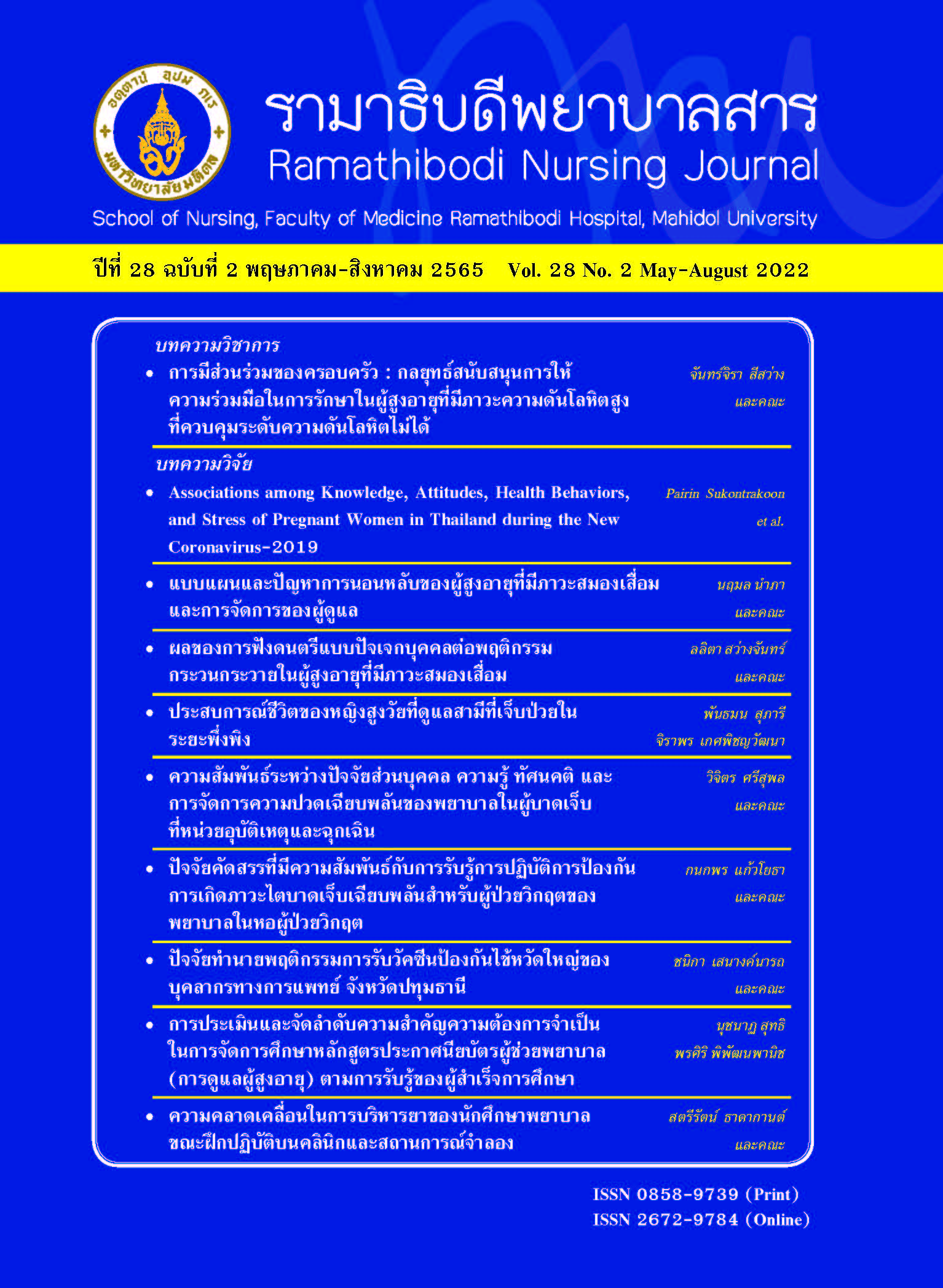Sleep Patterns and Sleep Problems in Older Persons with Dementia and Management by Caregivers
Main Article Content
Abstract
This descriptive study aimed to describe sleep patterns and sleep problems among older persons with dementia and management by their caregivers. Purposive sampling was used to recruit 88 community-dwelling older persons with any stage of dementia and 88 caregivers. The research instruments for older participants included the Demographic Questionnaire, sleep diaries, and wrist sleep trackers; those for caregivers included the Demographic Questionnaire, and the Caregivers’ Management of Sleep Problems in Older Persons with Dementia. The data were collected from June to August 2019 and then analyzed using descriptive statistics and chi-square. Almost all of the sleep data showed the polyphasic (sleeping many times per day) sleep pattern, while a few had biphasic (sleeping twice per day) and monophasic (sleeping once per day) sleep patterns. Sleep problems in the older sample included sleep-related breathing disorder (snoring), sleep talking,hyper-somnolence, and wake after sleep onset, respectively. Mainly, non-pharmacological interventions were used for sleep problems of older persons with dementia by caregivers,including promotion of relaxation, light exposure, sleep hygiene, and physical activities.However, one quarter used medications prescribed by doctors. Healthcare providers could use the results from this study to plan interventions for reducing the polyphasic sleep pattern,decreasing hypersomnia and excessive daytime sleepiness, and developing the educational program for caregivers about the management of sleep problems in older persons with dementia appropriately.
Keywords: Sleep patterns, Sleep problems, Sleep problem management, Older persons,Dementia
Article Details

This work is licensed under a Creative Commons Attribution-NonCommercial-NoDerivatives 4.0 International License.
บทความ ข้อมูล เนื้อหา รูปภาพ ฯลฯ ที่ได้รับการตีพิมพ์ในรามาธิบดีพยาบาลสาร ถือเป็นลิขสิทธิ์ของวารสาร หากบุคคลหรือหน่วยงานใดต้องการนำทั้งหมดหรือส่วนหนึ่งส่วนใดไปเผยแพร่หรือเพื่อกระทำการใด ใด จะต้องได้รับอนุญาตเป็นลายลักษณ์อักษรจากรามาธิบดีพยาบาลสารก่อนเท่านั้น
References
Mekawichai P, Saetang S. Caregiver burden among Thai dementia patients’ caregivers. Journal of the Psychiatrist
Association of Thailand. 2013;58(1):101-10. (in Thai)
Alzheimer’s Disease International. Dementia statistics;2017 [cited 2018 October 15]. Available from: https://
www.alz.co.uk/research/statistics. (in Thai)
Sittironnarit G. Behavioral and psychological symptoms of dementia (BPSD): concept and treatment. Journal of
the Psychiatrist Association of Thailand. 2011;56(4):449-62. (in Thai)
Cipriani G, Lucetti C, Danti S, Nuti A. Sleep disturbances and dementia. Psychogeriatrics. 2015;15(1):65-74.doi: 10.1111/psyg.12069.
Romsai W. Quality of sleep and related factors in caregivers of patients with dementia at dementia clinic, King Chulalongkorn Memorial Hospital. Bangkok: Chulalongkorn University; 2012. (in Thai)
Gibson RH, Gander PH, Jones LM. Understanding the sleep problems of people with dementia and their family caregivers. Dementia. 2014;13(3):350-65.
Bombois S, Derambure P, Pasquier F, Monaca C. Sleep disorders in aging and dementia. J Nutr Health Aging.
;14(3):212-7.
Maneethanue O. Selected factors related to sleep quality in older persons with Alzheimer’s disease [thesis].Bangkok: Chulalongkorn University; 2553. (in Thai)
Morgenthaler T, Kramer M, Alessi C, Friedman L,Boehlecke B, Brown, T, et al. Practice parameters for the psychological and behavioral treatment of insomnia: an update. An American Academy of Sleep Medicine Report.Sleep. 2006;29(11):1415–9.
Martin JL, Hakim AD. Wrist actigraphy. Chest. 2011;139(6):1514-27.
Stampi C. Evolution, chronobiology, and functions of polyphasic and ultrashort sleep: main issues. In: Stampi C,editor. Why we nap. Birkhäuser, Boston, MA; 1992. p. 1-20.https://doi.org/10.1007/978-1-4757-2210-9_1
Matuzaki L, Santos-Silva R, Marqueze EC, de Castro Moreno CR, Tufik S, Bittencourt, L. Temporal sleep patterns in adults using actigraph. Sleep Sci. 2014;7(3):152-7.
Jordan, P. The different types of sleep patterns–polyphasic,biphasic & monophasic. [Internet]. 2018, [cited 2020, Oct 1].
Available from: https://sleepsurge.com/sleep-patterns.
Sateia MJ. International classification of sleep disorders-Third edition: highlights and modifications. Chest. 2014;
(5):1387-94.
Panpanit L. Sleep problems in older people and nursing management. Journal of Nursing Science and Health
[Internet]. 2020 [cited 2021Apr 5];43(1):139-50.Available from: https://he01.tci-thaijo.org/index.php/nah/article/view/240808 (in Thai)
Urrestarazu E, Iriarte J. Clinical management of sleep disturbances in Alzheimer’s disease: current and emerging
strategies. Nat Sci Sleep. 2016;8:21–33. doi: 10.2147/NSS.S76706.
Marhoney FI, Barthel DW. Functional evaluation: the Barthel index. Md State Med J. 1965;14(1):61-5.
Jitapunkul S. Principles of geriatric medicine. Bangkok:Chulalongkorn University Printing House; 1998.
Carney CE, Buysse DJ, Ancoli-Israel S, Edinger JD,Krystal AD, Lichstein KL, et al. The consensus sleep diary:standardizing prospective sleep self-monitoring. Sleep.2012;35(2):287-302.
Marino M, Li Y, Rueschman MN, Winkelman JW,Ellenbogen JM, Solet JM, Buxton, et al. Measuring sleep:accuracy, sensitivity, and specificity of wrist actigraphy compared to polysomnography. Sleep. 2013;36(11):1747-55.
de Zambotti M, Goldstone A, Claudatos S, Colrain IM,Baker FC. A validation study of Fitbit Charge 2™ compared with polysomnography in adults. Chronobiol Int.2018;35(4):465-76.
Andrade AG, Bubu OM, Varga AW, Osorio RS. The relationship between obstructive sleep apnea and Alzheimer’s
disease. J Alzheimers Dis. 2018;64(s1): S255–70. doi:10.3233/JAD-179936.
Boeve A, Ferman TJ, Aakre J, St Louis E, Silber M,Machulda M, et al. Excessive daytime sleepiness in major dementia syndromes. Am J Alzheimers Dis. Other Demen.2019; 34(4):261–4. doi: 10.1177/1533317519828046.
Huang Y, Potter R, Sigurdson W, Santacruz A, Shih S,Ju YE, et al. Effects of age and amyloid deposition on Aβ dynamics in the human central nervous system. Arch Neurol. 2012;69(1):51-8.
Lim AS, Ellison BA, Wang JL, Yu L, Schneider JA,Buchman AS, et al. Sleep is related to neuron numbers in the ventrolateral preoptic/intermediate nucleus in older adults with and without Alzheimer’s disease. Brain.2014;137(10):2847-61.
Wang H, Zheng H, Augusto JC, Martin S, Mulvenna M,Carswell W, et al. Monitoring and analysis of sleep pattern for people with early dementia. In 2010 IEEE International Conference on Bioinformatics and Biomedicine Workshops (BIBMW); 2010. p. 405-10.
Insrichuen S, Choowattanapakorn T. The effect of nursing care using aromatherapy on sleep quality in older persons
with dementia. JFONUBUU. 2017;25(1):37-48.(in Thai)
McCurry SM, Pike KC, Vitiello MV, Logsdon RG, Larson EB, Teri L. Increasing walking and bright light exposure to improve sleep in community‐dwelling persons with Alzheimer’s disease: results of a randomized, controlled trial. J Am Geriatr Soc. 2011;59(8):1393-402.
Figueiro MG. Light, sleep and circadian rhythms in older adults with Alzheimer’s disease and related dementias.Neurodegener Dis Manag. 2017;7(2):119-45.
Blume C, Garbazza C, Spitschan M. Effects of light on human circadian rhythms, sleep and mood. Somnologie
(Berl). 2019; 23(3):147-56. doi:10.1007/s11818-019-00215-x.
Ooms S, Ju YE. Treatment of sleep disorders in dementia.Curr Treat Options Neurol. 2016;18(9):40. doi:10.1007/s11940-016-0424-3.


